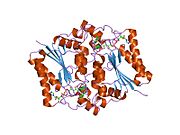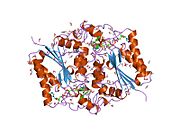NAD(P)H dehydrogenase, quinone 2
NAD(P)H dehydrogenase, quinone 2, also known as QR2, is a protein that in humans is encoded by the NQO2 gene. It is a phase II detoxification enzyme which can carry out two or four electron reductions of quinones. Its mechanism of reduction is through a ping-pong mechanism involving its FAD cofactor. Initially in a reductive phase NQO2 binds to reduced dihydronicotinamide riboside (NRH) electron donor, and mediates a hydride transfer from NRH to FAD. Then, in an oxidative phase, NQO2 binds to its quinone substrate and reduces the quinone to a dihydroquinone. Besides the two catalytic FAD, NQO2 also has two zinc ions. It is not clear whether the metal has a catalytic role. NQO2 is a paralog of NQO1.
NQO2 is a homodimer. NQO2 can be inhibited by resveratrol.[5] One of QR2's binding sites responds to 2-iodomelatonin, and has been referred to as MT3.[6]
References
[edit]- ^ a b c GRCh38: Ensembl release 89: ENSG00000124588 – Ensembl, May 2017
- ^ a b c GRCm38: Ensembl release 89: ENSMUSG00000046949 – Ensembl, May 2017
- ^ "Human PubMed Reference:". National Center for Biotechnology Information, U.S. National Library of Medicine.
- ^ "Mouse PubMed Reference:". National Center for Biotechnology Information, U.S. National Library of Medicine.
- ^ "Entrez Gene: NQO2 NAD(P)H dehydrogenase, quinone 2".
- ^ Cardinali DP, Delagrange P, Dubocovich ML, Jockers R, Krause DN, Markus RP, Olcese J, Pintor J, Renault N, Sugden D, Tosini G, Zlotos DP (2019). "Melatonin receptors (version 2019.4) in the IUPHAR/BPS Guide to Pharmacology Database". IUPHAR/BPS Guide to Pharmacology CITE. 2019 (4). doi:10.2218/gtopdb/F39/2019.4.
Further reading
[edit]- Jaiswal AK, Burnett P, Adesnik M, McBride OW (1990). "Nucleotide and deduced amino acid sequence of a human cDNA (NQO2) corresponding to a second member of the NAD(P)H:quinone oxidoreductase gene family. Extensive polymorphism at the NQO2 gene locus on chromosome 6". Biochemistry. 29 (7): 1899–906. doi:10.1021/bi00459a034. PMID 1691923.
- Jaiswal AK (1994). "Human NAD(P)H:quinone oxidoreductase2. Gene structure, activity, and tissue-specific expression". J. Biol. Chem. 269 (20): 14502–8. doi:10.1016/S0021-9258(17)36651-6. PMID 8182056.
- Zhao Q, Yang XL, Holtzclaw WD, Talalay P (1997). "Unexpected genetic and structural relationships of a long-forgotten flavoenzyme to NAD(P)H:quinone reductase (DT-diaphorase)". Proc. Natl. Acad. Sci. U.S.A. 94 (5): 1669–74. Bibcode:1997PNAS...94.1669Z. doi:10.1073/pnas.94.5.1669. PMC 19974. PMID 9050836.
- Wu K, Knox R, Sun XZ, et al. (1997). "Catalytic properties of NAD(P)H:quinone oxidoreductase-2 (NQO2), a dihydronicotinamide riboside dependent oxidoreductase". Arch. Biochem. Biophys. 347 (2): 221–8. doi:10.1006/abbi.1997.0344. PMID 9367528.
- Foster CE, Bianchet MA, Talalay P, et al. (1999). "Crystal structure of human quinone reductase type 2, a metalloflavoprotein". Biochemistry. 38 (31): 9881–6. doi:10.1021/bi990799v. PMID 10433694.
- Jaiswal AK, Bell DW, Radjendirane V, Testa JR (1999). "Localization of human NQO1 gene to chromosome 16q22 and NQO2-6p25 and associated polymorphisms". Pharmacogenetics. 9 (3): 413–8. doi:10.1097/00008571-199906000-00020. PMID 10471077.
- Harada S, Fujii C, Hayashi A, Ohkoshi N (2001). "An association between idiopathic Parkinson's disease and polymorphisms of phase II detoxification enzymes: glutathione S-transferase M1 and quinone oxidoreductase 1 and 2". Biochem. Biophys. Res. Commun. 288 (4): 887–92. doi:10.1006/bbrc.2001.5868. PMID 11688992.
- Strassburg A, Strassburg CP, Manns MP, Tukey RH (2002). "Differential gene expression of NAD(P)H:quinone oxidoreductase and NRH:quinone oxidoreductase in human hepatocellular and biliary tissue". Mol. Pharmacol. 61 (2): 320–5. doi:10.1124/mol.61.2.320. PMID 11809856.
- Strausberg RL, Feingold EA, Grouse LH, et al. (2003). "Generation and initial analysis of more than 15,000 full-length human and mouse cDNA sequences". Proc. Natl. Acad. Sci. U.S.A. 99 (26): 16899–903. Bibcode:2002PNAS...9916899M. doi:10.1073/pnas.242603899. PMC 139241. PMID 12477932.
- Okubo T, Harada S, Higuchi S, Matsushita S (2004). "Association analyses between polymorphisms of the phase II detoxification enzymes (GSTM1, NQO1, NQO2) and alcohol withdrawal symptoms". Alcohol. Clin. Exp. Res. 27 (8 Suppl): 68S–71S. doi:10.1097/01.ALC.0000078616.63296.41. PMID 12960511.
- Ostrousky O, Meged S, Loewenthal R, et al. (2004). "NQO2 gene is associated with clozapine-induced agranulocytosis". Tissue Antigens. 62 (6): 483–91. doi:10.1046/j.1399-0039.2003.00133.x. PMID 14617031.
- Harada S, Tachikawa H, Kawanishi Y (2005). "A possible association between an insertion/deletion polymorphism of the NQO2 gene and schizophrenia". Psychiatr. Genet. 13 (4): 205–9. doi:10.1097/00041444-200312000-00003. PMID 14639047. S2CID 37313428.
- Ota T, Suzuki Y, Nishikawa T, et al. (2004). "Complete sequencing and characterization of 21,243 full-length human cDNAs". Nat. Genet. 36 (1): 40–5. doi:10.1038/ng1285. PMID 14702039. S2CID 21903526.
- Kwiek JJ, Haystead TA, Rudolph J (2004). "Kinetic mechanism of quinone oxidoreductase 2 and its inhibition by the antimalarial quinolines". Biochemistry. 43 (15): 4538–47. doi:10.1021/bi035923w. PMID 15078100.
- Buryanovskyy L, Fu Y, Boyd M, et al. (2004). "Crystal structure of quinone reductase 2 in complex with resveratrol". Biochemistry. 43 (36): 11417–26. doi:10.1021/bi049162o. PMC 3650734. PMID 15350128.
- Wang W, Jaiswal AK (2005). "Sp3 repression of polymorphic human NRH:quinone oxidoreductase 2 gene promoter". Free Radic. Biol. Med. 37 (8): 1231–43. doi:10.1016/j.freeradbiomed.2004.06.042. PMID 15451063.
- Gerhard DS, Wagner L, Feingold EA, et al. (2004). "The status, quality, and expansion of the NIH full-length cDNA project: the Mammalian Gene Collection (MGC)". Genome Res. 14 (10B): 2121–7. doi:10.1101/gr.2596504. PMC 528928. PMID 15489334.
- Hsieh TC, Wang Z, Hamby CV, Wu JM (2005). "Inhibition of melanoma cell proliferation by resveratrol is correlated with upregulation of quinone reductase 2 and p53". Biochem. Biophys. Res. Commun. 334 (1): 223–30. doi:10.1016/j.bbrc.2005.06.073. PMID 15993843.
- Fu Y, Buryanovskyy L, Zhang Z (2005). "Crystal structure of quinone reductase 2 in complex with cancer prodrug CB1954". Biochem. Biophys. Res. Commun. 336 (1): 332–8. doi:10.1016/j.bbrc.2005.08.081. PMID 16129418.
- Rual JF, Venkatesan K, Hao T, et al. (2005). "Towards a proteome-scale map of the human protein-protein interaction network". Nature. 437 (7062): 1173–8. Bibcode:2005Natur.437.1173R. doi:10.1038/nature04209. PMID 16189514. S2CID 4427026.












